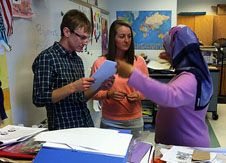Putting the cool in chemistry

“Everything we can touch, feel or smell, we can use chemistry to study,” said Principal Research Scientist Elham Ghabbour of the Department of Chemistry and Chemical Biology to a classroom of third-graders at Hardy Elementary School in Arlington, Mass. Each of the 26 students proudly donned safety glasses loaned by Northeastern’s Office of Environmental Health and Safety.
Last spring, the American Chemical Society contacted Ghabbour about a program that aims to excite young students about science. Ghabbour reached out to the local elementary school to gauge interest and was happily invited to visit in January.
Ghabbour, along with seniors Liz Duquette (an environmental science major with a concentration in marine biology) and Zack Bonin (a chemistry and environmental science combined major), presented five experiments addressing three chemical concepts: polymers, absorption and properties. Students learned about everything from chemical bonding to how to make “slime” by combining two different polymers.
Duquette drew a row of circles linked together with dashes on the chalkboard to explain polymers — a chain of small molecules linked together by chemical bonds. “Hair, skin, feathers and turtle shells are examples of natural polymers,” said Ghabbour.
Bonin poured water into a paper cup filled with a synthetic polymer used in baby diapers. To the students’ amazement, the polymer held the water in the cup when Bonin turned it upside down.
In preparing for the demonstrations, Duquette said she felt like a kid herself. She had expected it to be hard to get the students’ attention, “but when you give them something cool like that they’re totally engaged,” she said. “And they just kept wanting to know more.”
Bonin agreed, saying, “They were really understanding it.”
Ghabbour explained her own research, in which both Duquette and Bonin have participated, within the context of the three new concepts: humic acid, she explained, is a “polymer that holds water in the soil,” distinguishing backyard dirt from sand on a beach. “It absorbs nutrition for plants and releases it later when the plant needs it.”
At the end of the day, the students were reluctant to give back their safety glasses but expressed excitement that they might one day wear them again: “When I get older I think I want to take a science semester in high school or college,” wrote one student, summarizing the sentiment in many of the students’ thank-you notes. Ghabbour hopes to make this a tradition, opening more local students’ eyes to the wonders of chemistry.





